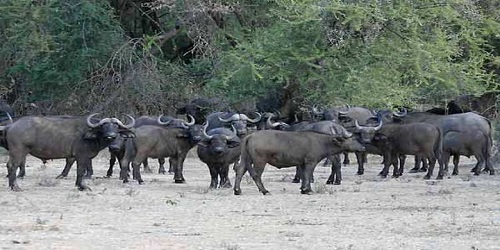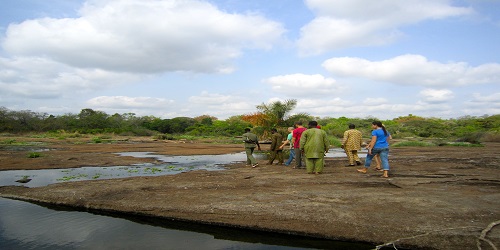
The Park is located in Oyo State, South-west Nigeria with an area of 2,512 square Kilometre, shaped like ‘Saxophone’ . It is 300 Km from Lagos, 60 Km from Ibadan, 160 Km from Ilorin, 600 Km from Abuja, 600 Km from Kaduna and 910 Km from Kano. Most of the Park area is covered by plains lowland, undulating from 300m to 500 m above sea level. Few hills, notable Yemoso and Gbogun, Kosomonu, however rise several meters above their general surrounding. The southern part is drained by the Owu, Owe and Ogun Rivers, while the northern sector is drained by the Tessi River.
Annual rainfall in the Park ranges is between 900 mm and 1,500 mm, and main annual temperature is between 12 degrees C and 37 degrees C. The rainy season begins in April through September with the highest rainfall record between July and August.Temperature is highest in the dry season with the mean daily maximal, which is greatest during February and March with values of about 33.6 degrees C with the lowest values of about 20 degrees C during the height of harmattan in December and January.
Old Oyo National Park was established to preserve the culture, historical and archaeological features in the abandoned sites of the then capital city of the ancient Oyo Empire at Oyo-ile, Bara and Koso, to protect, preserve, conserve and manage representative samples of indigenous flora and fauna of the south west geographical region of Nigeria, to encourage general interest and education among the public in the knowledge of wild fauna and flora and to gain their support for conservation, the conservation of selected and representative examples of wildlife communities in Nigeria, for the protection of endangered species of wild plants and animals and their habitats and to encourage the public to visit the National Park in order to enjoy and appreciate the aesthetic, spiritual and ecological values of nature in the maintenance of a healthy environment among others.
The Park offers a wide variety resources such as vast tracts of unspoiled nature, unique wildlife both fauna and flora and solid mineral deposits. Other attractions include: The ethno-historical attractions and traditional ways of life (culture) of the Yoruba race, illustrated in their type of food (Amala, gbegiri, ewedu and moimoi), hairstyle (Irun Didi), dress code (Soro&Buba) and authentic unsophisticated but friendly attitude of Oyo people which are worth trying for a memorable visit.
It is rich in fauna resource with significant species of which are the Buffon’s kob, kobuskob, Roan Antelope Hippotragus equines, Western hartebeest, Alcelaphusbuselaphus, Bush buck, Tragelaphusscriptus, baboon, Papio Anubis, Patas monkey, Erythrocebuspatas, Oribiourebiaourebi, Grimm’s duiker Sylvicappragrimmia, lion Pantheraleo, Warthog Phacochoerusaethiopicus, Water buck Kobusdefasa, Red Flanked Duiker Cephalophusrufilatus, Black and white Colobus monkey Colobusvellerous Green monkey Cercopithecusathieops and many more.The Park has unique and spectacular features of abundant water resources that drain most part of the park through-out the year like the Ibuya pool and the Ikere Gorge dam.

There is a great diversity of fish species in the major rivers and the pools/lakes. The physical environment of these rivers and pools provide viable recreational activities for tourists such as sport fishing, haggling, boat cruising, Bird sighting and water polo, picnicking etc.
Old Oyo National Park contain solid mineral deposit such as Tantalite, Columbite, Granite, Marble stone and many more both at Sepeteri and Oyo-ile axis of the Park. In addition, it should be noted that Igbeti town is acknowledged for Marble stone deposit as Obajanna in Kogi State is well-known for Cement deposit.
The uniqueness of the Old Oyo National Park is a fascinating pocket of archaeological, cultural and historical sites dotted with in and around the Park. Old Oyo National Park is most unique of all the National Park in the country because it is the only one with dual prospect of both archaeological as well as cultural/historical Park.




